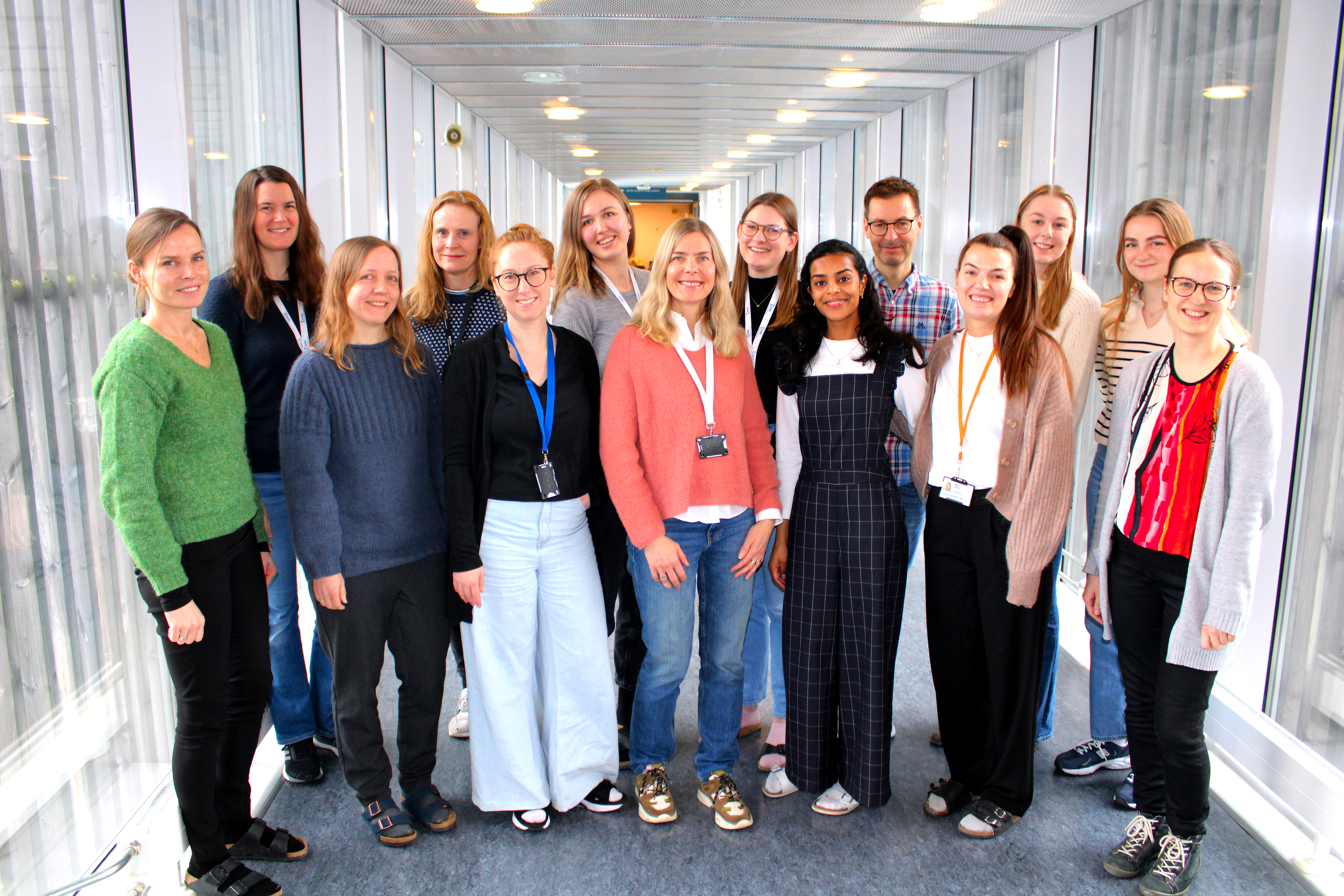Molecular Mechanisms of Mycobacterial and Viral Infections - CEMIR
Molecular Mechanisms of Mycobacterial and Viral Infections (MYCOVIR)

Mycobacteria and HIV can cause life-long infections and pose a global health challenge.
The COVID-19 pandemic further exemplifies how infectious diseases can paralyze society and cripple the world economy.
Tuberculosis (TB), caused by Mycobacterium tuberculosis (Mtb), kills about 1.5 million people each year and the prevalence of non-tuberculous mycobacterial infections caused by M. avium is increasing in individuals who are immunocompromised. Mycobacterial infections require long treatment with antibiotics, and drug resistance is emerging. About 35 million people world-wide are infected with HIV and need life-long treatment with anti-viral drugs to survive. COVID-19, for which there is no specific treatment, has 115 million confirmed cases and 2,5 million deaths.
Research focus
Our primary research focus is the molecular host defense mechanisms involved in immunity to mycobacteria, HIV and SARS-CoV2 and virulence strategies employed by these pathogens to parasitize host cells. Intracellular trafficking, compartmentalized pattern recognition receptor signaling, host cell killing, and nutrient metabolism are central processes currently investigated in our lab. Most of our work is on the cell biology of infection or in mouse infection models, but we do collaborate with clinicians on translational research projects.
We also just established induced pluripotent stem cell (iPSC)-derived macrophages and will continue with building lung-mimetic multicellular models for studying infections. We believe our basic research strategy may contribute to revealing new therapeutic targets and adjunct host-directed therapies, as well as in vaccine development.
Research documentation
10 selected publications
10 selected publications
- Åsberg SA*, Mediaas SD*, Marstad A, Ryan L, Louet C, Sporsheim B, Beckwith KS, Underhill DM, Gidon A#, Flo TH#. Frontline Science: Antibiotic Treatment Routes Mycobacterium Avium to Phagolysosomes Without Triggering Proinflammatory Cytokine Production in Human MØs. J Leukocyte Biol. 2021; 109: 23– 33. https://doi.org/10.1002/JLB.4HI0420-306R.
- Beckwith KS*, Beckwith MS*, Ullmann S, Sætra R, Kim H, Marstad A, Åsberg SE, Strand TA, Stenmark HA, Flo TH. Plasma membrane damage causes NLRP3 activation and pyroptosis during Mycobacterium tuberculosis infection. Nature Commun 11, 2270 (2020). https://doi.org/10.1038/s41467-020-16143-6
- Meås HZ*, Haug M*, Beckwith MS, Louet C, Ryan L, Hu Z, Landskron J, Nordb. SA, Task.n K, Yin H, Damås JK, Flo TH. Sensing of HIV-1 by TLR8 activates human T cells and reverses latency. Nature Commun 11, 147 (2020). https://doi.org/10.1038/s41467-019-13837-4.
- Dragset MS, Ioerger TR, Loevenich M, Haug M, Sivakumar N, Marstad A, Cardona PJ, Klinkenberg G, Rubin EJ, Steigedal M, Flo TH. Global Assessment of Mycobacterium avium subsp. hominissuis Genetic Requirement for Growth and Virulence. mSystems. 2019 Dec 10;4(6). pii: e00402-19. doi:10.1128/mSystems.00402-19.
- Mildenberger J, Johansson I, Sergin I, Kjøbli E, Damås JK, Razani B, Flo TH, Bjørkøy G. N-3 PUFAs induce inflammatory tolerance by formation of KEAP1-containing SQSTM1/p62-bodies and activation of NFE2L2. Autophagy. 2017 Oct 3;13(10):1664-1678. doi: 10.1080/15548627.2017.1345411.
- Gidon A, Åsberg SE, Louet C, Ryan L, Haug M, Flo TH. Persistent mycobacteria evade an antibacterial program mediated by phagolysosomal TLR7/8/MyD88 in human primary macrophages. PLoS Pathog. 2017 Aug 14;13(8):e1006551. doi: 10.1371/journal.ppat.1006551.
- Awuh JA, Haug M, Mildenberger J, Marstad A, Do CP, Louet C, Stenvik J, Steigedal M, Damås JK, Halaas Ø, Flo TH. Keap1 regulates inflammatory signalling in Mycobacterium avium-infected human macrophages. Proc Natl Acad Sci U S A. 2015 Aug 4;112(31):E4272-80.
- Steigedal M, Marstad A, Haug M, Damås JK, Strong RK, Roberts PL, Himpsl SD, Stapleton A, Hooton TM, Mobley HL, Hawn TR, Flo TH. Lipocalin 2 imparts a selective pressure on bacterial growth in the bladder and is elevated in women with urinary tract infection. J Immunology, 2014 Dec;193(12):6081-9
- Halaas Ø, Steigedal M, Haug M, Awuh JA, Ryan L, Brech A, Sato S, Husebye H, Cangelosi GA, Akira S, Strong RK, Espevik T, Flo TH. Intracellular Mycobacterium avium intersect transferrin in the Rab11+ recycling endocytic pathway and avoid lipocalin 2 trafficking to the lysosomal pathway. J Infect Dis. 2010 Mar;201(5):783-92.
- Flo TH, Smith KD, Sato S, Rodriguez DJ, Holmes MA, Strong RK, Akira S, Aderem A. 2004. Lipocalin 2 mediates an innate immune response to bacterial infection by sequestrating iron. Nature. 432(7019):917-21.
PubMed
PubMed
Publications by Trude Helen Flo and Magnus Steigedal - PubMed
"flo t[au] OR steigedal m[au]"
NTNU Open
People
Collaborations
- Norbert Reiling, PD Dr. Research Center Borstel, Germany.
- TS Keshava Prasad, Professor at Yenepoya University, Mangalore, India.
- Maria Lerm, Professor at Linkøping University, Sweden.
- David M. Underhill, Professor, Cedars-Sinai Medical Center, LA USA and CEMIR.
- Egil Lien and Kate Fitzgerald, Professors, University of Massachusetts Medical School, Massachusetts, USA and CEMIR.
- Roland Brosch, Professor at Institut Pasteur, Paris, France.
- Anne Ma Dyrhol-Riise, MD and Professor at Oslo University Hospital, Norway.
- Kjetil Tasken, Centre Director, Centre for Molecular Medicine Norway (NCMM), University of Oslo, Norway.
- Yannick Schwab, Teamleader at EMBL Heidelberg, Germany.
- Anne Simonsen, Professor at Institute of Basic Medical Sciences, University of Oslo, Norway.
- Harald Stenmark, Professor at University of Oslo /Oslo University Hospital, Norway.
